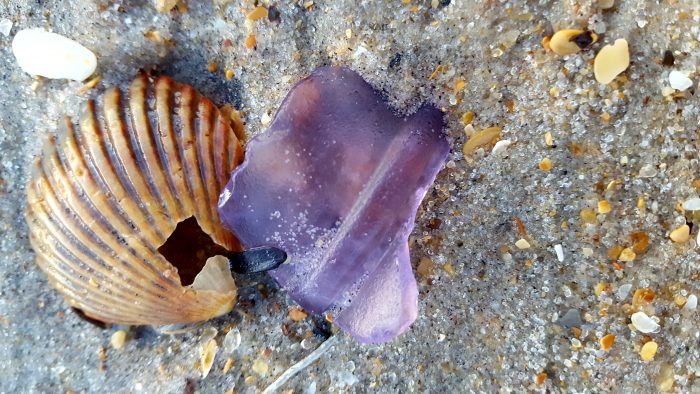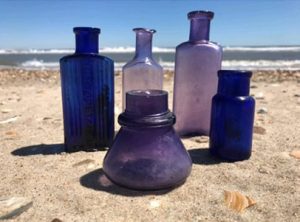
Seaglass collecting is an exciting hobby that’s growing in popularity on the Outer Banks. The treacherous waters and historical events that have occurred along the shores of this sandbar contribute to the abundance of seaglass that can be found. Although beachcombing is nothing new to the area, especially to a lot of longtime residents, collecting seaglass is fairly modern.
Seaglass comes mainly from old, broken glass bottles. These bottles could have been tossed off a boat from a sailor a hundred years ago, or maybe just stem from someone’s trash pit that was swept into the ocean from the late 1800s. However, the bottles made it to the sea, and their broken, smoothed and frosty pieces are what makes up most the seaglass beachcombers find.
A small percentage of seaglass comes from decorative items like vases or goblets. An even smaller percentage comes from electrical insulators and the very coveted glass marbles and shooters. Items like these are how a collector tends to find the rarest seaglass colors like yellow, red and purple. Of these rare colors, I find the purple color to be the most fascinating.

Before plastic, every single item was produced as glass bottles. Everything from Clorox to Listerine, medicines to ketchup, and even Gatorade was made as glass bottles. The oldest bottles that can be found in our area can be dated back to the 1700s, and were liquor bottles. Purple bottles are unusual to find, because true purple glass was not commonly used, and in fact, most purple bottles found these days started off as clear bottles.
This means that purple seaglass which is found typically was not from a purple vessel, but in fact started off as part of a clear bottle. Glass makers use the organic compound manganese dioxide, or manganesum, which comes from the Manganese element. This compound is used to neutralize other colors in glass, like the green tint given off by iron.
Using a small amount of manganesum does not have a color-changing effect, but a heavy amount would make the vessel a shade of purple, depending on the amount used. The more of the chemical that was used, the more saturated the color. From the 1800s to the early 1900s, almost all glassmakers were using this element in their formulas.
Manganese was mined in Africa, and during the early 1900s, Germany gained control of these mines, making it virtually impossible to obtain the element. Glass makers were forced to switch to selenium, which was much more affordable and available. This is significant to seaglass collectors, because it helps date pieces.
It was discovered later that glass bottles made with manganesum eventually turn purple from UV-rays that hit the glass. The longer the exposure, the richer the color purple can develop, in addition to the amount of manganese dioxide used. Glass made with selenium does not change color after UV exposure, which can mean that most purple seaglass likely dates before the 1920s. Of course, not all purple glass was made this way, but most items that were mass-produced were.
Finding a true purple piece is a real treat for dedicated seaglass collectors, as these items were usually made only for the very wealthy. A purple perfume bottle or a glass bead or bottle stopper are all items a seaglass hunter dreams of finding. Maybe the beautiful Outer Banks will gift one to you one day – Happy hunting!



